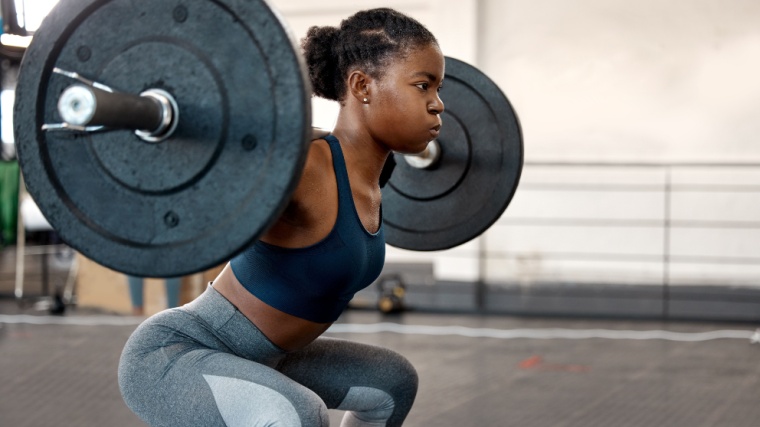The debate over training to failure to build muscle and strength is basically a Looney Toons skit at this point — wabbit season, duck season. But new research and fresh perspectives may finally tip the scales.
- BarBend sat down with one of the industry’s most influential thought leaders, bodybuilder and PhD Dr. Eric Helms, to discuss the cutting-edge research on whether or not you should train to failure.
More importantly, we examined what happens if you don’t. Here’s the good news: You might not need to, at least for certain exercises. We’ll let Dr. Helms explain.

Training to Failure: The Latest
Our conversation with Dr. Helms began after listening to him discuss an assortment of compelling, newly published (or on the way) research about training to failure on the Iron Culture podcast.
What started as a simple email exchange blossomed into a crash course on how to interpret scientific studies and glean real, practical information from them. Dr. Helms was kind enough to dig deep on some of the latest data.
[Related: Best Pre-Workout Supplements]
The data itself comes from the study “Exploring the Dose-Response Relationship Between Estimated Resistance Training Proximity to Failure, Strength Gain, and Muscle Hypertrophy: A Series of Meta-Regressions” by Dr. Zac Robinson and Joshua C. Pelland. (1)
As of Oct. 2024, Mr. Pelland is in the final stages of publishing his doctoral thesis, which covers a number of interesting adjacent topics. We’ll circle back to that down the line.
Conventional weight room wisdom (along with a large body of scientific works) indicates that training to failure isn’t strictly necessary, but getting damned close to it is a muscle-building must. There is, of course, plenty of nuance to determining just how close and how often you should train to failure to optimize hypertrophy.
To cut through the static, we posed a singular question to Dr. Helms: Would you recommend most bodybuilders avoid training to failure when working with weights at or above 90% of their max?
Here’s what he had to say, plus the additional research he used to support his arguments:
“Robinson’s study found that while training closer to failure made a set more stimulative, there are other moderating factors,” Dr. Helms said. “Specifically, they found that the heavier the load, the less of an impact going to failure had on the hypertrophy stimulus.”
- Caveat: This doesn’t mean you can get jacked by lifting, say, your five-rep max for one rep at a time. “A set needs to have a minimum number of reps to last long enough to provide a stimulus,” Dr. Helms said. “That number seems to be around four or five reps.” (2)
So far, so good: The heavier you’re lifting, the less important training to failure becomes (within reason). On one hand, it’s much easier to “lift heavy” on a free-weight compound exercise like the squat or deadlift. When it comes to isolation exercises, Dr. Helms thinks things change a bit.
[Related: Best Whey Protein Powders]
“Exercise selection is an important consideration here, practically speaking,” Dr. Helms noted. “Multi-joint exercises taken to failure for higher reps can exacerbate discomfort and make it harder to maintain a high training quality for the remainder of the session.”
- Simply put: You certainly could kick off your leg days by training to failure on heavy squats. It just might not afford you any muscle-building advantage to do so, and will likely affect the rest of the workout.
Training to Failure: How To Do It Right
Interpreting all this scientific information can be a doozy, so here are Dr. Helms’ general prescriptions for when you should be training to failure:
“Intelligent pairing of exercises, rep ranges, and RIR (reps in reserve) ensure you can perform the intended volume and loads, while ensuring your assessment of proximity to failure is accurate, maximizing the stimulus of that session.”
Here’s how that might look on a leg day:
- Romanian Deadlift: Sets of 4-6, with 3-4 RIR
- Leg Press: Sets of 6-8, with 2-3 RIR
- Leg Curl: Sets of 8-12, with 0-2 RIR, and the last set taken to true failure
- Leg Extension: Sets of 12-15, with 0-1 RIR, and the last set taken to true failure
- Calf Raise: Sets of 8-15, with 0 RIR
[Related: Best Supplements for Bodybuilding]
Training To Failure: The Big Picture
For big, meat-and-potatoes bodybuilding exercises, work with a weight that’s somewhat close to your max (Dr. Helms advises a load that falls somewhere around your 5 to 8-rep max), but leave three to five reps in the tank.
As you progress through your workout, gradually train closer and closer to failure while turning to stable, single-joint exercises on machines or cables.
More Training Content
- 5 Science-Based Hacks for Muscle Growth That Actually Work
- The “4+1” Protocol for Easy-Mode Calf Gains
- The Laziest Way to Do More Pull-Ups (That Works)
References
- Robinson ZP, Pelland JC, Remmert JF, Refalo MC, Jukic I, Steele J, Zourdos MC. Exploring the Dose-Response Relationship Between Estimated Resistance Training Proximity to Failure, Strength Gain, and Muscle Hypertrophy: A Series of Meta-Regressions. Sports Med. 2024 Sep;54(9):2209-2231. doi: 10.1007/s40279-024-02069-2. Epub 2024 Jul 6. PMID: 38970765.
- Schoenfeld BJ, Grgic J, Van Every DW, Plotkin DL. Loading Recommendations for Muscle Strength, Hypertrophy, and Local Endurance: A Re-Examination of the Repetition Continuum. Sports (Basel). 2021 Feb 22;9(2):32. doi: 10.3390/sports9020032. PMID: 33671664; PMCID: PMC7927075.
Featured Image: Yuri A. / Shutterstock